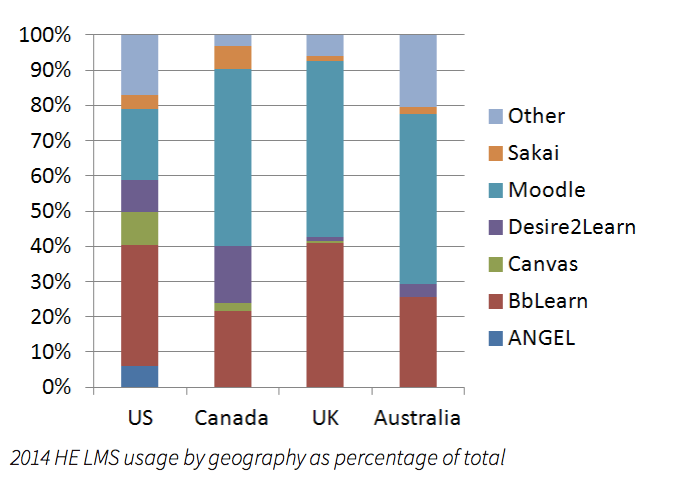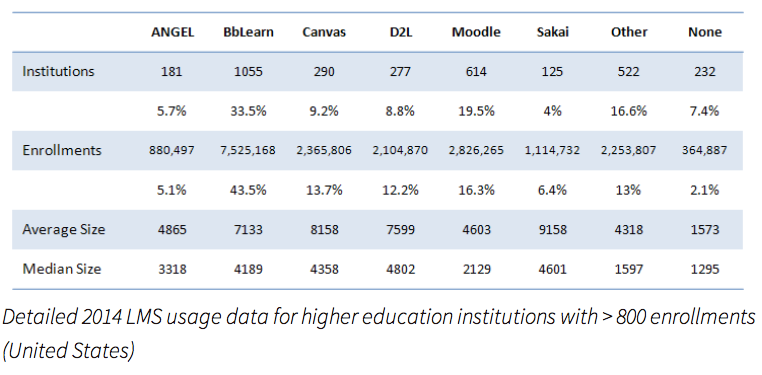In Fall 2013 we saw a rich source of LMS market data emerge.
George Kroner, a former engineer at Blackboard who now works for University of Maryland University College (UMUC), has developed what may be the most thorough measurement of LMS adoption in higher education at Edutechnica (OK, he’s better at coding and analysis than site naming). This side project (not affiliated with UMUC) started two months ago based on George’s ambition to unite various learning communities with better data. He said that he was inspired by the Campus Computing Project (CCP) and that Edutechnica should be seen as complementary to the CCP.
The project is based on a web crawler that checks against national databases as a starting point to identify the higher education institution, then goes out to the official school web site to find the official LMS (or multiple LMSs officially used). The initial data is all based on the Anglosphere (US, UK, Canada, Australia), but there is no reason this data could not expand.
There is new data available in Edutechnica’s one-year update, with year-over-year comparisons available as well as improvements to the methodology. Note that the methodology has improved both in terms of setting the denominator and in terms of how many schools are included in the data collection.
The Fall 2014 data which now includes all schools with more than 800 enrollments:
There’s more data available on the site, including measures of the Anglosphere (combining US, UK, Canada and Australia data) as well as comparison tables for 2013 to 2014. Go read the whole post.

- Blackboard’s BbLearn and ANGEL continue to lose market share in US –1 Using the 2013 to 2014 tables (> 2000 enrollments), BbLearn has dropped from 848 to 817 institutions and ANGEL has dropped from 162 to 123. Using the revised methodology, Blackboard market share for > 800 enrollments now stands at 33.5% of institutions and 43.5% of total enrollments.
- Moodle, D2L, and Sakai have no changes in US – Using the 2013 to 2014 tables (> 2000 enrollments), D2L has added only 2 schools, Moodle none, and Sakai 2 schools.
- Canvas is the fasted growing LMS and has overtaken D2L – Using the 2013 to 2014 tables (> 2000 enrollments), Canvas grew ~40% in one year (from 166 to 232 institutions). For the first time, Canvas appears to have have larger US market share than D2L (13.7% to 12.2% of total enrollments using table above).
- BbLearn is popular in the UK while Moodle is largest provider in Canada and Australia – The non-US numbers are worth reviewing, even without the same amount of detail as we have for US numbers.
While this data is very useful, I will again point out that no one to my knowledge has independently verified the accuracy of the data at this site. I have done sanity checks against Campus Computing and ITC data, but I do not have access to the Edutechnica specific mechanism for counting systems. In order to gain longer-term acceptance of these data sets, we will need some method to provide some level of verification.
In the meantime, enjoy the new market data.
Update: Allan Christie has a post up questioning the source data for Australia. I hope this information is used to improve the Edutechnica data set or at least leads to clarifications.
Put simply, it is generally accepted that there are 39 universities (38 public, 1 private) in Australia. Given the small number of universities and my knowledge of the sector I know that there are 20 (51%) universities which use Blackboard as their enterprise LMS, 16 (41%) use Moodle, and 3 (8%) use D2L. It is acknowledged that there are some departments within universities that use another LMS but according to Edutechnica’s methodology these were excluded from their analysis.
- Disclosure: Blackboard is a client of MindWires Consulting. [↩]

I thought that Blackboard bought Angel… so its no surprise that the number of “Angel” clients is decreasing as they are becoming Blackboard clients. This reporting summary seems a bit odd.
Blackboard bought ANGEL in 2009 and at one point planned to discontinue. Two years ago they changed plans, and ANGEL is currently a separate product line from BbLearn, even though owned by the same company. This is why the reporting keeps them separate. See this post for more:
https://eliterate.us/angel-lms-dead-or-alive/
I’ve copied my comment to Allan here for posterity’s sake. Thank you for the feedback, and please keep it coming. -George
Hi Allan, Thank you for your feedback and your own independent analysis of Australian universities. My reply to you from last year still holds true. I copy it below verbatim from Phil’s original post last year. https://eliterate.us/new-data-available-higher-education-lms-market/ In short, I do not consider the list of the 39 universities to be a complete representation of higher education in Australia. In our analysis we include TAFEs, other private institutions, and other accredited institutions as detailed here and elsewhere: http://en.wikipedia.org/wiki/List_of_universities_in_Australia. We have a similar situation for Canada and the UK where there is no authoritative, comprehensive list of institutions. In the US, however, the US Department of Education provides a complete, authoritative list of all higher education institutions, and as such we do not have this type of variance. The Sakai institution that you mention, however, was indeed a single miss on our part last year, and it appears that they are still running Sakai today.
—————————————–
Thank you, Allan, for your feedback. Most of our initial effort with this particular project went towards cleaning the US dataset for all institutions with more than 2000 students. As Phil indicates, with our lessons learned from this exercise we are now better able to revise our international data.
Perhaps I jumped the gun on Charles Sturt. Admittedly, I was involved with that project while a Blackboard employee and chalked it up as a Blackboard win. That said, for institutions who noted an impending decommissioning of an LMS, we noted this and eliminated the decommissioned environment from our rankings. For example, University of Melbourne also has a Sakai environment (https://sakai.unimelb.edu.au/portal), but it is clearly noted that it will soon be shut down. Other schools use Sakai as a research or collaboration environment and not as a primary LMS. There are also other reasons that we could have mis-identified an LMS. By default these were lumped into the “other” category for later analysis. It’s just that we haven’t gotten there yet for Australia.
As for the discrepencacy about the number of institutions, we included TAFEs, for-profit, and private institutions in our analysis – not just public institutions. TEQSA, for example, shows 177 “education providers” in Australia: http://www.teqsa.gov.au/national-register/search/provider. To be consistent with the sources of institutional data in the other geographies, we included these institutions in our Australian analysis.
Again, we do greatly appreciate your feedback and especially your regional perspective on how we can improve the quality of our data and analysis. Thank you, and please keep it coming.